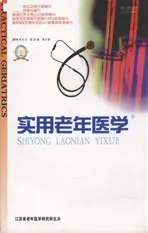老年肌少症的肌肉形态结构病理生理变化
2016-04-04冯丽盛云露宗立翎刘娟丁国宪
冯丽 盛云露 宗立翎 刘娟 丁国宪
·讲座与综述·
老年肌少症的肌肉形态结构病理生理变化
冯丽盛云露宗立翎刘娟丁国宪
肌少症是一类以进行性的、广泛性的骨骼肌量和肌力减少以及骨骼肌功能减退为特征,进而导致机体功能和生活质量下降甚至死亡的综合征[1]。在全球其发病率逐年增高,目前已成为威胁老年人健康,影响老年人生活质量的重要危险因素。肌少症的诊断包括3个要素,即肌量减少、肌力减少和肌肉功能减退。肌少症不仅会增加残疾、跌倒、骨折的风险,降低生活质量,还会增加罹患糖尿病、骨关节炎、冠状动脉等疾病的危险[2]。
肌少症的发生与机体活动量的减少、营养不良、氧化应激、生长激素及类固醇激素分泌异常有关[3]。有研究表明肌肉量在儿童及青中年时期逐渐增加,到40岁左右达到稳定,之后会以1%~2%的速度逐年降低[4]。据Patel等[5]统计,人体总的肌肉量从40~80岁下降30%~50%,肌肉功能50岁以后每年下降1%~2%,60岁以后每年下降达到3%。Vandervoort等[6]及Russ等[7]发现肌肉横截面积在60岁以后每年下降1%~2%。HealthABC研究表明肌肉力量的下降速度远比肌肉量的下降速度快,肌肉量不变的情况下肌肉力量仍会随着年龄增加而下降[8]。观察细胞水平肌肉结构的增龄性变化,发现主要表现为肌纤维结构及神经肌肉系统的显著改变,因此本文主要详细介绍这一变化。
1 骨骼肌正常生理结构
1.1骨骼肌基本生理结构骨骼肌组织的基本构成单位为肌细胞,因其呈细长纤维状,又称为肌纤维。肌纤维为多核细胞,细胞间有结缔组织、毛细血管及神经纤维等,其细胞膜称为肌膜,细胞质称为肌质,肌质中含丰富的肌原纤维,成簇状依肌细胞长轴排列,其外由结缔组织膜包裹,肌质中还有线粒体为肌肉活动提供能量、糖原储存能量以及肌红蛋白储存和释放氧。肌纤维由上千条粗细肌丝依肌细胞长轴排列,其中粗肌丝由肌球蛋白分子构成,细肌丝由肌动蛋白、原肌球蛋白、肌钙蛋白构成[9]。
骨骼肌在人体内广泛分布,约600多块,占人体质量的40%,不同人体、不同部位的肌肉中,肌肉纤维类型及分布比例不同,相应的功能也不同[10-11],肌纤维的组成受肌肉的功能特征、性别、年龄以及遗传的影响。在细胞水平,依据所含肌球蛋白亚型的不同[如肌球蛋白重链(MHC)及肌球蛋白轻链,其中肌球蛋白重链是影响肌肉纤维类型中最主要的亚型][9],可将骨骼肌纤维分为3种类型,即慢肌纤维、快肌纤维及介于二者之间的耐疲劳肌纤维。慢肌纤维包含较少数量的肌纤维,由Ⅰ型肌球蛋白重链构成,其转换能量的速度较慢。富含线粒体及肌红蛋白,且分布的毛细血管网丰富,因此为红色,又称为红肌纤维。它可以通过氧化分解脂类及碳水化合物获得大量ATP,其氧化过程相对缓慢,这样有益于维持长时间的有氧活动,如长跑,因此,慢肌纤维多用于较长时间的肌肉活动以及抗阻运动。快肌纤维可产生较大的力量及较快的速度,肌纤维横截面积较大,所含的肌纤维数量较多,分布毛细血管网相对较少,它主要含有Ⅱx肌球蛋白重链,能量转换速度快,所含线粒体较少,其活动所需能量来源于糖酵解,可在短时间内提供大量的能量,多用于要求短时间产生大量能量的运动,例如举重、快跑;第3种肌纤维为耐疲劳肌纤维,其耗氧速度、横截面积、肌纤维数量及收缩速度介于Ⅰ、Ⅱ型肌纤维之间,由Ⅱa型肌球蛋白重链构成[9,12]。
1.2神经-运动单位神经肌肉系统的基本构成单位为神经-运动单位。单个的运动神经元及肌肉纤维及支配其的神经束总体称为运动单位。通常情况下,较小的肌肉受神经的精细调节,该类神经只支配少量的肌肉纤维;较大的肌肉纤维受单独的神经束支配,该类神经可支配较多数量的肌肉纤维。当神经纤维接近肌肉时,失去髓鞘并分成细支,末端膨大形成卵圆形小板状隆起附着于肌纤维表面,形成突触前膜并与之相对应的肌纤维膜构成运动终板。该突触内含有大量的乙酰胆碱,当神经冲动传到神经纤维终末时,乙酰胆碱从突触膜释放,作用于与之相对的肌肉纤维膜上的乙酰胆碱受体,引起肌膜电位发生变化,导致肌肉收缩。肌肉收缩则是由ATP分解供能,粗细肌丝间滑行导致肌节缩短,完成收缩[13]。
2 老年肌少症肌肉形态结构病理变化
肌肉年龄相关的改变包括肌肉量、形态结构、收缩性能的改变。有研究显示随年龄增加,男性肌肉量下降较女性显著,最先表现为下肢肌肉量的减少,而且下肢肌肉量的减少远胜于上肢。肌肉纤维结构的变化则主要为肌纤维变细,尤其是Ⅱ型纤维[14]。Lexell等[15]在镜下观察股外侧肌增龄性变化,发现30岁以后肌肉出现萎缩,最先出现的是肌肉数量的减少,无明显纤维类型的区别,肌肉大小无明显变化(只有少量的Ⅱ型肌纤维的减小),之后,随着年龄增加,出现肌肉大小减小,尤其是Ⅱ型肌纤维。Lee等[16]也通过对肌肉横截面积、肌纤维数量、大小研究证实了上述结果。这些变化主要是由于肌肉纤维形态结构及运动单位的改变引起的。
2.1肌肉纤维形态结构病理改变老年肌肉改变主要表现为肌肉纤维横截面积缩小,神经支配减少,肌肉组织快肌纤维向慢肌纤维的适应性转变。最终这样的转变导致肌肉量、力量以及功能减弱,造成了身体活动能力减弱、残疾,增加跌倒的风险。
电镜下观察肌纤维变化,可见肌纤维核移至中央,出现环状纤维,纤维断裂、破碎及虫蚀样变,甚至出现空泡[17]。有许多原因相互叠加导致肌肉结构的紊乱,其中由于蛋白合成障碍及破坏过多导致的蛋白代谢异常最重要。但最近有研究发现老年人蛋白合成率与年轻人无明显差异[18]。近年来新的研究发现老年人蛋白摄入不足,吸收功能差,活动后蛋白合成反应减慢,出现蛋白赤字影响了雷帕霉素信号通路,激活了泛素蛋白酶体通路[19-21],同样能诱发细胞“自噬”,导致肌肉纤维破坏,破坏的细胞器及细胞碎片堆积进一步加速细胞死亡,导致肌肉量减少[22]。进一步观察发现,肌少症肌肉变化在电镜下表现为肌球蛋白及肌动蛋白量减少,有研究显示肌球蛋白重链的合成率随年龄增长而降低[23]。有研究发现老年鼠半膜肌肌球蛋白与肌动蛋白的比例下降,但对中老年人群比目鱼肌肌纤维观察则未发现二者的比例减少。说明二者比例的减少在不同的年龄阶段、不同的肌肉类型表现不同[24-25]。此外Hook等[26]发现肌动蛋白肌丝滑行速度随年龄增长而下降。原肌球蛋白及肌钙蛋白在肌丝滑动过程中起到暴露肌球蛋白上ATP结合位点的作用,该蛋白异常亦会导致肌肉收缩功能异常。有研究表明随年龄增长该种蛋白的表达量下降,转录后修饰增加[27-28],但此方面的研究较少,还有待于进一步研究。
Goodpaster等[29]还发现随着年龄增加,各组肌肉间及肌束间脂肪细胞增加,有研究显示由于脂肪细胞释放细胞因子导致肌肉损伤,脂肪细胞越多,肌肉力量下降越明显[30]。对于肌肉的血供,Jakobsson等[17]在镜下观察发现老年组Ⅱ型肌纤维周围分布的毛细血管较青年组明显减少,而Ⅰ型肌纤维则无明显改变。
2.2神经肌肉系统改变运动单位是神经肌肉收缩功能的基本单位,由脊髓a神经元、运动神经纤维及其分支以及所支配的肌肉纤维构成[31]。每一运动神经元大约有50000个神经末梢分支作用于肌纤维,其分布受许多因素影响[13]。
随着年龄增加,肌肉及其相关的神经系统都会有损伤,进而导致肌肉功能下降。有研究检测腰骶部a运动神经元(尤其支配快肌纤维的神经元)发现,从20~100岁平均减少25%,较严重者60岁以后总量只剩下年轻时的50%,且脊髓神经前根神经轴的数量及直径均减小[32-33]。Morita等[34]则发现老年人脊髓的兴奋性较年轻人明显降低。
周围神经及髓鞘镜下改变,可见肌肉神经节点减少、末端膨大变大,突触小泡减少,神经递质减少,慢肌纤维末梢可见神经萌芽及侧支增加[35]。Doherty等[36]测量轴突传递速度发现随年龄增长而减慢,大量的纤维失神经并且阶段性脱髓鞘,神经节节间长度减小。神经肌肉系统末端——运动单位也发生年龄相关的改变。慢肌运动单位数量变化较小,但是每个运动单位所包含的纤维数量增加3倍;相反的,快肌运动单位减少34%,而且每个运动单位所包含的纤维减少86%[37]。
有研究显示肌肉量的减少最早发生的是肌肉单元的减少。运动单元在生长过程中不断地经历失神经-再重塑的过程。随年龄增加,运动单元的失神经大于重塑,最终完全失去神经支配直至凋亡[38]。在早期,老年人运动单元的失神经改变由于神经重塑作用不能被检测到,肌肉量及力量无明显改变,这一时期的改变主要为脊髓神经元凋亡及轴突变性[39-40]。肌肉纤维失去神经支配后,其中部分肌纤维得到邻近的健全神经元新的神经萌芽的支配而得以再生,但新生成的运动单元较肥大,且运动速度减慢。在人类,失神经纤维主要为Ⅱ型肌纤维,因此随着运动神经纤维的重塑,大部分完好的Ⅰ型运动单元的神经萌芽伸出侧支支配失神经支配的Ⅱ型肌纤维,导致Ⅱ型肌纤维向Ⅰ型肌纤维的转变[41]。
神经肌肉接点则表现为运动终板重塑。终板突触前膜及突触后膜的神经末梢分支增加,突触后膜上乙酰胆碱受体破坏,突触后结构由神经末梢取代。有研究表明老年小鼠废用性肌肉比健康老年小鼠及青年小鼠肌肉的肌肉神经节点的重塑更加明显[42]。
肌肉结构、肌肉神经系统增龄性改变最终导致肌肉量、肌肉力量、收缩功能下降,对人类健康、寿命、生活质量均带来威胁,明显增加了患病率及致残率。近几年在临床医学研究中对老年人肌肉减少的问题越来越重视,同时对该问题的认识也逐渐加深。这将有利于我们及早发现、诊断肌少症,并及早进行干预,改善患者的生活质量。
[1]Fielding RA, Vellas B, Evans WJ,et al. Sarcopenia: An undiagnosed condition in older adults current consensus definition: prevalence, etiology, and consequences. International working group on sarcopenia[J].J Am Med Dir Assoc, 2011,12(4):249-256.
[2]Cruz-Jentoft AJ, Baeyens JP,Bauer JM, et al. Sarcopenia: European consensus on definition and diagnosis: Report of the European Working Group on Sarcopenia in Older People[J].Age Ageing,2010,39(4):412-423.
[3]Kamel HK.Sarcopenia and Aging[J]. Nutr Rev,2003, 61 (5 Pt 1):157-167.
[4]Sayer AA, Robinson SM, Patel HP,et al. New horizons in the pathogenesis, diagnosis and management of sarcopenia[J]. Age Ageing,2013,42(2):145-150.
[5]Patel HP,Syddall HE, Jameson K,et al. Prevalence of sarcopenia in community-dwelling older people in the UK using the European Working Group on Sarcopenia in Older People (EWGSOP) definition: findings from the Hertfordshire Cohort Study (HCS)[J].Age Ageing,2013,2(3):378-384.
[6]Vandervoort AA. Ageing of the human neuromusclar system[J].Muscle Nerve, 2002, 25(1): 17-25.
[7]Russ DW, Gregg-Cornell K, Conaway MJ, et al. Evolving concepts on the age-related changes in “muscle quality”[J]. J Cachexia Sarcopenia Muscle, 2012,3(2):95-109.
[8]Delmonico MJ, Harris TB, Visser M, et al. Longitudinal study ofmuscle strength, quality,and adipose tissue infiltration[J]. Am J Clin Nutr,2009,90(6):1579-1585.
[9]Brooks SV.Current topics for teaching skeletal muscle physiology[J].Adv Physiol Educ, 2003,27(1/4):171-182.
[10]Pette D,Staron RS. Myosin isoforms, muscle fiber types, and transitions[J].Microsc Res Tech,2000,50(6):500-509.
[11]Ruegg C, Veigel C, Molloy JE,et al. Molecular motors: force and movement generated by single myosin II molecules[J]. News Physiol Sci, 2002,17:213-218.
[12]Lang T,Streeper T, Cawthon P,et al.Sarcopenia:etiology,clinical consequences, intervention,and assessment[J].Osteoporos Int, 2010,21(4):543-559.
[13]Powers RK, Binder MD.Input-output functions of mammalian motoneurons[J].Rev Physiol Biochem Pharmacol,2001,143:137-263.
[14]Janssen I, Heymsfield SB, Wang ZM,et al. Skeletal muscle mass and distribution in 468 men and women aged 18-88 yr[J]. J Appl Physiol(1985),2000,89(1):81-88.
[15]Lexell J, Taylor CC, Sjöström M.What is the cause of the ageing atrophy? Total number, size and proportion of different fiber types studied in whole vastus lateralis muscle from 15- to 83-year-old men[J].J Neurol Sci,1988,84(2/3):275-294.
[16]Lee WS, Cheung WH, Qin L,et al. Age-associated decrease of typeⅡA/B human skeletal muscle fibers[J]. Clin Orthop Relat Res, 2006,450:231-237.
[17]Jakobsson F,Borg K,Edström L,et al.Fibre-type composition, structure and cytoskeletal protein location of fibres in anterior tibialmuscle. Comparison between young adults and physically active aged humans[J].Acta Neuropathol,1990,80(5):459-468.
[18]Cuthbertson D,Smith K, Babraj J,et al. Anabolic signaling deficits underlie amino acid resistance of wasting, aging muscle[J].FASEB J,2005,19(3):422-444.
[19]Guillet C, Prod’homme M, Balage M,et al. Impaired anabolic response of muscle protein synthesis is associated with S6K1 dysregulation in elderly humans[J]. FASEB J,2004,18(13):1586-1587.
[20]Drummond MJ, Dreyer HC, Pennings B,et al. Skeletal muscle protein anabolic response to resistance exercise and essential amino acids is delayed with aging[J].J Appl Physiol(1985),2008,104(5):1452-1461.
[21]Altun M, Besche HC, Overkleeft HS,et al. Muscle wasting in aged, sarcopenic rats is associated with enhanced activity of the ubiquitin proteasome pathway[J]. J Biol Chem,2010,285(51):39597-39608.
[22]Wohlgemuth SE,Seo AY, Marzetti E,et al. Skeletal muscle autophagy and apoptosis during aging: effects of calorie restriction and life-long exercise[J].Exp Gerontol,2010,45(2):138-148.
[23]Thompson LV, Durand D, Fugere NA,et al. Myosin and actin expression and oxidation in aging muscle[J]. J Appl Physiol (1985),2006,101(6):1581-1587.
[24]Clark BC. In vivo alterations in skeletal muscle form and function after disuse atrophy[J]. Med Sci Sports Exerc,2009,41(10):1869-1875.
[25]Riley DA, Bain JL, Thompson JL,et al. Decreased thin filament density and length in human atrophic soleus muscle fibers after spaceflight[J].J Appl Physiol (1985),2000,88(2):567-572.
[26]Hook P, Sriramoju V,Larsson L. Effects of aging on actin sliding speed on myosin from single skeletal muscle cells of mice, rats and humans[J].Am J Physiol Cell Physiol,2001,280(4):C782-C788.
[27]Kawai M,Ishiwata S.Use of thin filament reconstituted muscle fibres to probe the mechanism of force generation[J].J Muscle Res Cell Motil,2006,27(5/7):455-468.
[28]Kanski J, Hong SJ,Schöneich C. Proteomic analysis of protein nitration in aging skeletal muscle and identification of nitrotyrosine-containing sequences in vivo by nanoelectrospray ionization tandem mass spectrometry[J]. J Biol Chem,2005,280(25):24261-24266.
[29]Goodpaster BH, Kelley DE, Thaete FL,et al. Skeletal muscle attenuation determined by computed tomography is associated with skeletal muscle lipid content[J]. J Appl Physiol (1985),2000,89(1):104-110.
[30]Christie A, Kamen G. Short-term training adaptations in maximal motor unit firing rates and afterhyperpolarization duration[J].Muscle Nerve,2010,41(5):651-660.
[31]Kullberg S, Ramíez-León V,Johnson H,et al.Decreased axosomatic input to motoneurons and astrogliosis in the spinal cord of aged rats[J].J Gerontol A Biol Sci Med Sci,1998,53(5):B369-B379.
[32]Tomlinson BE, Irving D.The numbers of limb motor neurons in the human lumbosacral cord throughout life[J].J Neurol Sci,1977,34(2):213-219.
[33]Robertson WC Jr,Kawamura Y, Dyck PJ. Numbers and diameter histograms of alpha and gamma axons and ventral roots[J]. Neurology,1978,28(10):1057-1061.
[34]Morita H, Shindo M, Yanagawa S, et al. Progressive decrease in heteronymous monosynaptic Ia facilitation with human ageing[J]. Exp Brain Res,1995,104(1):167-170.
[35]Ramírez V, Ulfhake B. Anatomy of dendrites in motoneurons supplying the intrinsic muscles of the foot sole in the aged cat: evidence for dendritic growth and neo-synaptoge-nesis[J].J Comp Neurol,1992,316(1):1-16.
[36]Doherty TJ, Vandervoort AA, Taylor AW, et al.Effects of motor unit losses on strength in older men and women[J].J Appl Physiol (1985),1993,74(2):868-874.
[37]Kadhiresan VA,Hassett CA,Faulkner JA. Properties of single motor units in medial gastrocnemius muscles of adult and old rats[J].J Physiol,1996,493(Pt 2): 543-552.
[38]Gordon T, Hegedus J, Tam SL. Adaptive and maladaptive motor axonal sprouting in aging and motoneuron disease[J]. Neurol Res,2004,26(2):174-185.
[39]McNeil CJ, Doherty TJ,Stashuk DW,et al.Motor unit number estimates in the tibialis anterior muscle of young, old, and very old men[J].Muscle Nerve,2005,31(4):461-467.
[40]McNeil CJ, Vandervoort AA, Rice CL.Peripheral impairments cause a progressive age-related loss of strength and velocity-dependent power in the dorsiflexors[J].J Appl Physiol (1985),2007,102(5):1962-1968.
[41]Doherty TJ, Brown WF. The estimated numbers and relative sizes of thenar motor units as selected by multiple point stimulation in young and older adults[J].Muscle Nerve,1993,16(4):355-366.
[42]Siu PM, Alway SE. Response and adaptation of skeletal muscle to denervation stress: the role of apoptosis in muscle loss[J].Front Biosci (Landmark Ed),2009,14:432-452.
210029江苏省南京市,南京医科大学第一附属医院老年内分泌科
丁国宪,Email:dinggx@njmu.edu.cn
R 592; R 681
Adoi:10.3969/j.issn.1003-9198.2016.06.017
2016-02-01)
